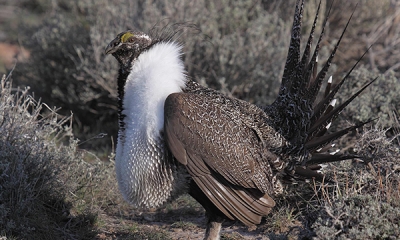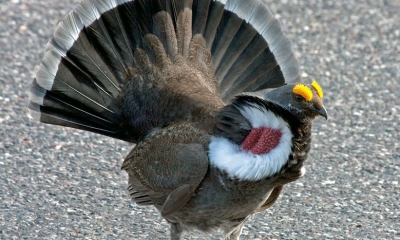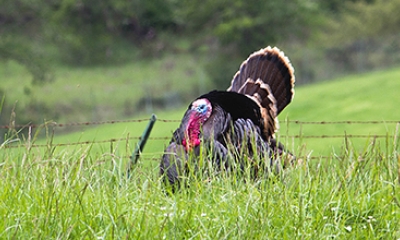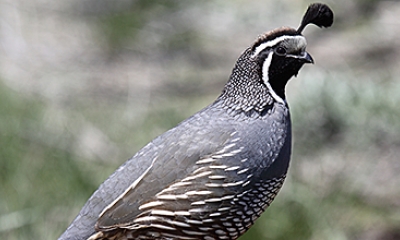
Pheasants, Grouse, Quail and Turkey
Pheasants, grouse, quail and turkey are upland game birds.

Types of Pheasants, Grouse, Quail and Turkey

Chukars are ground-loving birds that quickly run uphill or burst from cover with rapid wing-beats and a characteristic whitoo call if alarmed.
Introduced by managers wishing to increase hunting opportunities in arid western North America, the chukar is a very successful exotic species that occupies habitats where few other gamebirds exist. It is the most harvested upland bird in Oregon.
It is a common permanent resident of eastern Oregon. Populations are distributed in steppe habitats along the breaks of the Columbia, John Day, Snake, Owyhee, Deschutes, Malheur, Burnt and Grand Ronde rivers and lesser watercourses or reservoirs.
Photo by Dave Budeau, ODFW

The gray partridge was released in North America as early as 1790 from its native range in Europe and Asia, but it was not until the 1900s that this stocky gamebird became well established in many states. It is also called the Hungarian partridge (or Hun) by hunters.
The gray partridge currently thrives mainly in the valleys of the northeast and Columbia Basin counties of Oregon.
Photo by Dave Miller, Flickr

Oregon hosted the first successful introduction of the ring-necked pheasant in North America. This exotic game bird, released for sport hunting from China is now widely introduced and distributed throughout North America.
Although more likely to run than fly, the ring-necked pheasant will explode into the air if startled, producing a distinctive sound from rapid wing-beats.
It inhabits open areas such as grasslands, agricultural fields, and brushy areas, and avoids forested habitats.
Hear the call of the ring-necked pheasant
Photo by Charlotte Ganskopp

Ruffed grouse are named for a series of black iridescent feathers on the sides of the neck called the ruff, which is erected by males to form an ring around the neck during courtship displays.
This forest-dwelling species, favored by upland game-bird hunters, is well known for the drumming of the males during courtship displays in the spring.
It is a common resident throughout most forested regions of the state. It occupies most forests at low to moderate elevations east of the Cascade crest, primarily the east slope of the Cascades from Ft. Klamath and upper Klamath Lake and Blue Mountains, but also forested aspen stands of southeast Oregon desert regions.
Hear the call of the ruffed grouse
Photo by Dave Budeau, ODFW

Greater sage-grouse are best known for their elaborate courtship displays that occur on traditional strutting grounds, known as leks, where males gather each spring.
At all seasons, both sexes are readily identified by large size and chicken-like build. Adults are mottled dark gray, black and buff, with black bellies and pointed tails. Males have specializations used in display. Their tail feathers are long and pointed with white spots. They have yellow combs over each eye and a chest sac with two bare, yellow patches of skin which are inflated during display. The display lasts only a few seconds and is a combination of color, movement and sound.
They are most common in the southeastern desert regions of the state and generally limited to sagebrush habitats. Greater sage-grouse are an Oregon Conservation Strategy Species in both the Blue Mountains and Northern Basin and Range ecosystems.
Hear the call of the greater sage-grouse
Oregon Sage-Grouse Development Siting Tool
Photo by Charlotte Ganskopp

This northern grouse reaches Oregon only in the forests of the Wallowa Mountains in the northeastern part of the state.
It is dusky and slightly smaller than the ruffed grouse. Sexes are different in coloration; males have a black breast with white spotting on the sides, white spots at the base of a black tail, and a red comb above the eye. Females are heavily barred with dark brown and white and have a dark tail.
Hear the call of the spruce grouse
Photo by Dave Budeau, ODFW

This popular upland game bird is the largest of Oregon's three forest grouse.
It is well known for the distinctive hooting call emitted by courting males in the spring. This call is accompanied by an extravagant courtship display involving exposure of blood-engorged, featherless shoulder spots and eye combs, which are reddish to orange.
It is a common resident in coniferous forests.
Hear the call of the dusky grouse
Photo by Jim Dollar, Flickr

An Oregon native, sooty grouse occupy the coniferous forests of western Oregon, the eastern slopes of the Cascades, the Blue Mountains of northeastern Oregon, and the Klamath Basin and South Warner Mountains.
Preferred habitat includes timber edges, open timbered slopes and mountain meadows, often adjacent to springs or other sources of water. They are often associated with berry producing areas such as chokecherry thickets.
Hear the call of the sooty grouse
Photo by ©Keith Kohl, ODFW

Columbian sharp-tailed grouse, commonly called "prairie chickens" by early Oregon residents, were abundant in the grasslands and foothills of Oregon east of the Cascade Mountains prior to the late 1800s but were considered extirpated from the state by the 1970s. Recent reintroduction programs give a glimmer of hope that sharp-tails may once again hold their own in northeast Oregon.
Males congregate on leks or dancing grounds in the spring and perform elaborate social displays. The Columbian sharp-tailed grouse is an Oregon Conservation Strategy Species in the Blue Mountains ecoregion.
Hear the call of the Columbian sharp-tailed grouse
Photo by Mike Hanson

The wild turkey is the largest game bird in North American with mature males weighing upwards of 20 pounds and standing 40 inches tall.
These large terrestrial birds are generally dark brown to black in appearance but iridescent color in feathers ranging from gold and copper to green and black gives a metallic appearance, particularly in full sunlight. Males and about 10 percent of females sport a unique beard of keratinous filament that protrudes from the junction of the breast and neck. Beards grow continuously but rarely exceed 10 inches in length. Females are smaller and duller in appearance.
Densities are the highest in forests and interspersed open habitats at low to mid-elevation mountains west of the Cascades. Turkeys are occasionally found at high elevations in southwestern and eastern Oregon mountains.
For tips on coexisting with wild turkeys, visit our Living with Wildlife, Turkeys page.
Hear the call of the wild turkey
Photo by Diana Ranslam

This is the largest native quail in North America and one of the least understood. Males and females have identical plumage characterized by distinctive white flank barring and prominent vertical head plumes.
Their eastern Oregon range appears reduced from historical accounts. Mountain quail are considered occasional in Union and Wallowa counties. They have also been observed along many of the tributaries of the John Day River in Wheeler and Grant counties and some in Wasco, Jefferson, Deschutes and Crook counties. In western Oregon, they are found in most forested mountainous areas generally above 1,640 feet, but may move to valley bottoms in winter.
Mountain quail are an Oregon Conservation Strategy Species in the Northern Basin and Range ecosystem.
Hear the call of the mountain quail
Photo by Dave Budeau

California quail are the most widely distributed upland game birds in Oregon. Most easily recognized by the comma-shaped, black, plume, or "topknot," which bends forward and is larger on the male.
It has been a resident statewide since the early 1900s, except for most forests of the north Coast Range and west Cascades; it is generally absent along the coast north of Coos Bay. California quail is also absent from high-elevation areas of the east Cascade range. They are common residents in rural and even some suburban areas, particularly in eastern Oregon where many coveys gather at feeding stations during the winter.
Hear the call of the California quail
Photo by Charlotte Ganskopp

